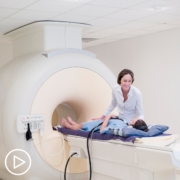Tag Archive for: The Pro-Active Myeloma Patient Toolkit
How Do Myeloma Test Results Guide Prognosis and Treatment?
How Do Myeloma Test Results Guide Prognosis and Treatment? from Patient Empowerment Network on Vimeo.
Myeloma specialist Dr. Peter Forsberg explains how myeloma test results help in assessing the disease stage and prognosis, and how identification of chromosomal abnormalities may aid in treatment decisions.
Dr. Peter Forsberg is assistant professor of medicine at the University of Colorado School of Medicine and is a specialist in multiple myeloma. More about Dr. Forsberg here.
Download Program Resource Guide
See More From The Pro-Active Myeloma Patient Toolkit
Related Resources:
Transcript:
Katherine:
What do the results of these tests tell us about prognosis and treatment choices?
Dr. Forsberg:
So, the tests that we do are important in terms of understanding some degree how aggressive the myeloma may be or what the prognosis may be. One of the most common or challenging things to break through when diagnosing myeloma or learning about your myeloma is that it’s a little different than other types of cancer. Unlike other cancers that’re more common, stage in myeloma is very different than it is in breast cancer or lung cancer or things that people may have more experience with. In myeloma, everybody has systemic disease.
That’s a part of the diagnosis of myeloma. It means it’s a body-wide condition. So, being stage I or II or III is very different than what it might be in other diseases where that has a huge prognostic impact and also, really shapes what treatment might be. In myeloma, we do use blood tests and chromosomal changes to help us assign a stage to the myeloma, which may tell us about how aggressive the myeloma may be over time.
But our treatment approaches tend to be pretty similar, even for people regardless of their stage. So, our goals are always to get patients’ myeloma under control and maintain it there. So, treatment ends up overlapping pretty substantially. Regardless of what those in initial tests are that stratify potential disease aggressiveness. That being said, there are some ways that we do adjust treatment potentially in patients that we see evidence of potentially more aggressive disease or less. And that might be ways that we amplify treatment regiments, adding extra medicines or using maintenance approaches that’re a little more robust to try to help overcome those high-risk features.
Katherine:
What about the significance of chromosomal abnormalities?
Dr. Forsberg:
So, chromosomal abnormalities are part of some of those staging systems. They’re included in what we call our revised international staging system, as well as just being part of our routine risk assessment.
To try to understand myeloma. So, in myeloma, at this point those genetic changes or chromosomal changes don’t necessarily drive specific treatment choices except in that they may stratify how aggressive disease could be and may be informative in that regard.
Myeloma Treatment Decisions: What’s Right for You?
Myeloma Treatment Decisions: What’s Right for You? from Patient Empowerment Network on Vimeo.
When choosing an myeloma treatment, what should be considered? Dr. Peter Forsberg, a myeloma specialist, reviews key decision-making factors, treatment options for myeloma, including combination approaches, and shares advice on advocating for yourself.
Dr. Peter Forsberg is assistant professor of medicine at the University of Colorado School of Medicine and is a specialist in multiple myeloma. More about Dr. Forsberg here.
Download Program Resource Guide
See More From The Pro-Active Myeloma Patient Toolkit
Related Resources:

Why Myeloma Patients Should Speak Up: Advice from a Nurse Practitioner |
Essential Imaging and Chromosome Tests After a Myeloma Diagnosis |
Transcript:
Katherine:
Hello, and welcome. I’m Katherine Banwell, your host for today’s program. Today, we’ll discuss how you can be proactive in your myeloma care. And work with your healthcare team to find the best treatment plan for you.
Joining me is Dr. Peter Forsberg. Dr. Forsberg, thank you so much for joining us. Joining me is Dr. Peter Forsberg. Dr. Forsberg, would you please introduce yourself?
Dr. Forsberg:
Sure. My name is Dr. Peter Forsberg. I’m a multiple myeloma specialist. I work at the University of Colorado and I’m happy to be here.
Katherine:
Thank you. A reminder that this program is not a substitute for seeking medical advice. Please refer to your healthcare team about what might be right for you. Well, Dr. Forsberg, let’s start with the basics. What is multiple myeloma?
Dr. Forsberg:
So, multiple myeloma is a blood cancer. It comes from cells that live in your bone marrow called plasma cells. They’re part of your immune system. And when they do their job, they help protect you from infections.
They’re antibody producing cells. In myeloma, unfortunately something changes in those cells and they begin to grow and live beyond what they normally would. So, myeloma is a disease that results from that and when myeloma is diagnosed, it’s usually because those plasma cells or the antibody they produce has started to cause problems. To cause destructive changes or symptoms. So, that’s multiple myeloma.
And it’s maybe a little more common than people sometimes think. It’s got an unusual name, so most folks haven’t really heard of myeloma when they’re diagnosed with it. But it is the 14th most common cancer and there are about 30,000 cases diagnosed each year in the US and at this point, more than 150,000 people living with myeloma. And that’s because more and more people are living with myeloma all the time. Advancements in treatment have made people live longer and live better with myeloma.
Katherine:
What testing should take place following a myeloma diagnosis?
Dr. Forsberg:
So, after a patient is diagnosed with myeloma, or with suspected myeloma, a number of tests take place to both understand the myeloma. Get some sense for how aggressive the myeloma might be and understand what may be being caused by the myeloma at any given time. So, that involves a number of blood tests. It involves checking urine, doing at least one 24-hour collection of urine. Doing imaging, tests to look at the skeleton or different areas of the body for myeloma involvement.
And a bone marrow biopsy and what’s called an aspirate. So, all those tests together are used to help confirm myeloma, to understand what’s going on with it and then to understand some of the characteristics of it that might be important over time.
Some of the more complicated tests when people are initially diagnosed with myeloma to get their head around are some pretty important blood tests that we monitor pretty closely.
Things called the serum protein electrophoresis and serum light chain assays. And basically, those are tools that help us measure antibodies. Myeloma is a disease; it comes from cells that make antibodies or fragments of antibodies. And by measuring those, we can understand the myeloma, we can give it some names. And then we can also measure it over time. So, those can seem a little bit impenetrable to patients when they’re first diagnosed, but they’re pretty important for patients and for people treating the myeloma to understand where the myeloma stands and how things are going
Katherine:
What about genetic testing?
Dr. Forsberg:
So, the main way that we use genetic testing in multiple myeloma is through something called, cytogenetics. And cytogenetics is a way for us to evaluate chromosomes.
Chromosomes are in cells and that’s where genetic material is contained. And in myeloma, some of the main vents that drive myeloma cells to change from normal plasma cells come through changes in chromosomes.
And so, those chromosome changes that can be detected with different tests, sometimes they’re called karyotyping or what’s called FISH can give us a sense for some of the changes that may drive the myeloma or have driven it in the first place.
And also, some of the tools that tell us a bit how aggressive the myeloma may be. Certain changes within chromosomes may say that a myeloma may be a little bit more on the aggressive end of the spectrum. Because it is certainly a spectrum of aggressiveness that myeloma can display.
Katherine:
What do the results of these tests tell us about prognosis and treatment choices?
Dr. Forsberg:
So, the tests that we do are important in terms of understanding some degree how aggressive the myeloma may be or what the prognosis may be. One of the most common or challenging things to break through when diagnosing myeloma or learning about your myeloma is that it’s a little different than other types of cancer. Unlike other cancers that’re more common, stage in myeloma is very different than it is in breast cancer or lung cancer or things that people may have more experience with. In myeloma, everybody has systemic disease.
That’s a part of the diagnosis of myeloma. It means it’s a body wide condition. So, being stage one or two or three is very different than what it might be in other diseases where that has a huge prognostic impact and also, really shapes what treatment might be. In myeloma, we do use blood tests and chromosomal changes to help us assign a stage to the myeloma, which may tell us about how aggressive the myeloma may be over time.
But our treatment approaches tend to be pretty similar, even for people regardless of their stage. So, our goals are always to get patients’ myeloma under control and maintain it there. So, treatment ends up overlapping pretty substantially. Regardless of what those in initial tests are that stratify potential disease aggressiveness. That being said, there are some ways that we do adjust treatment potentially in patients that we see evidence of potentially more aggressive disease or less. And that might be ways that we amplify treatment regiments, adding extra medicines or using maintenance approaches that’re a little more robust to try to help overcome those high-risk features.
Katherine:
What about the significance of chromosomal abnormalities?
Dr. Forsberg:
So, chromosomal abnormalities are part of some of those staging systems. They’re included in what we call our revised international staging system, as well as just being part of our routine risk assessment.
To try to understand myeloma. So, in myeloma, at this point those genetic changes or chromosomal changes don’t necessarily drive specific treatment choices except in that they may stratify how aggressive disease could be and may be informative in that regard.
Katherine:
Are there common misconceptions you hear when you see a new myeloma patient for the first time?
Dr. Forsberg:
Yeah, I think some of the more common questions that come up involve those questions like I mentioned about things like stage and understanding this unique characteristic to myeloma. Myeloma unfortunately remains an incurable disease in the year 2020. So, some of the questions come up regarding what prognosis or treatment approaches may entail. Certainly, going to not up to date sources can lead to a lot of misconceptions about what our options are and what our outlook might be for myeloma.
And certainly at times, patients wonder where the myeloma came from. Is there something that I did or that I was exposed to that was a real driver for me to develop this. That’s a really common question that comes up. And unfortunately, or fortunately, the answer is not really any that we know well about. So, let me rephrase. So, one question that comes up a lot is what may have caused the myeloma.
Is there something that someone did or was exposed to that drove the myeloma. And truthfully, at this point there aren’t a lot of drivers for myeloma that we know about. So, usually that’s something that can be a little hard to understand or to reconcile. But it is a type of disease that can, unfortunately, can affect anyone. It does get more common as people get older. But aside from some potential genetic impact or mild increased risk in family members and with certain ethnic groups.
Not a lot of historical things that were done might drive the development of myeloma.
Katherine:
Well, Dr. Forsberg, when deciding on a treatment approach with a patient, what do you take into account when making the decision?
Dr. Forsberg:
So, there’s pretty substantial factors that may impact treatment decision with myeloma. Our goal in almost all patients is to try to get the myeloma under control. Usually when we diagnose myeloma, it’s pretty active. Often, it’s causing significant problems. So, our goal in all patients is trying to get the myeloma under control to some degree.
Now, how aggressive we may be towards that is impacted by a number of things. One of the most important ones is who the patient is. Myeloma is diagnosed and it never develops in a vacuum. It always develops in a person and that person may have substantial other medical problems. They may be younger; they may be older. They may be more fit or more frail. So, those are all factors that may contribute to our initial treatment choice.
Because often, what we’re initially deciding on is how many medicines we may use initially to try to treat the myeloma. And our goal my be to try to push a little harder, to try to achieve the deepest possible remission. In those circumstances, in certain patients, we may incorporate things like a stem cell transplant as one of our second steps.
In patients who are somewhat less robust, we may be thinking that our primary goal is just to achieve and maintain control of the myeloma.
But not necessarily pushing for the deepest possible remission. Balancing the potential side effects from medicines with the importance of stopping the negative affects that the myeloma drives.
Katherine:
What about treatment choices? What does that mean exactly?
Dr. Forsberg:
So, aside from deciding on a spectrum of intensity for therapy that may be the most appropriate for a given patient. In terms of treatment choices, that may be focused primarily on which combination we use to treat the myeloma. There are some pretty standard options that’ve been pretty well validated now.
We’re lucky in myeloma to now have a pretty robust body of data regarding the treatments we use for patients with newly diagnosed myeloma. Incorporating modern, very active and often well tolerated medicines into combinations. But there are emerging questions about how to use new medicines in terms of patients with new myeloma that can be something that’s worth discussion with a provider.
So, sometimes the question may be, which three drug combination. The three-drug combination versus a two-drug combination appropriate. Or should we even be thinking about a four-drug combination to begin the treatment of the myeloma. After that, one of the biggest treatment questions regards the role of stem cell transplant, which remains an important treatment consideration for many myeloma patients diagnosed even in the modern era. After that, the question come around maintenance.
What’s the right maintenance therapies? Because in myeloma, even after getting the myeloma under control, often our best way to optimize people’s long-term outlook is to stay on some amount of continuous medication for the long term.
So, those are all treatment choices that’re made in conjunction with your provider. But it is almost always the right step to begin treatment for the myeloma, to try and stop those destructive changes and to stabilize someone once they’ve been diagnosed.
Katherine:
Any talk about treatment goals and what that means?
Dr. Forsberg:
So, as I mentioned, treatment goals may be different person to person. It takes into consideration who the patient is, what their priorities may be. What’s important for them in terms of not only living with the myeloma, but their life in general. So, there are many patients where our goal is to achieve a very robust, very long duration remission.
And there may be other patients where our goal isn’t just to control the myeloma, but to minimize treatment related side effects. So, our priorities may be somewhat different. But almost always, it is to prevent issues that may come up from the myeloma and we’re luck that often times those treatment goals align with tools we’re able to bring to bear. Our medicines for myeloma can help us achieve the goals of treatment, whether that’s achieving the deepest possible remission and sustaining it or prioritizing quality of life across a very broad patient spectrum.
Katherine:
What do you feel is the patient’s role in the decision and how does shared decision making come into play?
Dr. Forsberg:
So, I think it’s always a really important piece of the puzzle to be a part of the decision-making process. Myeloma can be a challenging disease to understand. There are some pretty significant nuances in terms of what our treatment options are and what our goals may be.
So, I think having a patient who is involved in that process, who is actively asking questions. Engaging their provider if something doesn’t make sense. If our goal is not clear. Trying to make sure that you ask that. As oncologists, a lot of what we do involves communication and trying to help bridge gaps between our understanding of diseases and treatments and what patients see and feel and understand.
So, I think it’s really a critical piece of it for patients to ask questions, to engage. Now, I will say that one of the important things is often when the myeloma is newly diagnosed, we do need to move into treatment in a relatively timely manner. So, engaging with that process, being ready to move forward is our key components.
Katherine:
Now that we’ve discussed factors that go into the treatment choice, would you walk us through the currently available myeloma treatment approaches and who they might be right for?
Dr. Forsberg:
So, I’ve already alluded to some of these. At this point, we’re lucky that we have a much broader toolkit to treat myeloma than we have had in the past. Myeloma is one of the successes in modern oncology in that way. At this point, we have a number of targeted therapies. Some of those are pill-based options, some are injections or infusional medicines. We have some immunotherapies, which are things like monoclonal antibodies, which help to work.
We use some conventional or older fashioned chemotherapy, often lower doses and as part of combinations. And steroids. Steroids are always the medicine that is one of the backbones of our combinations. In myeloma, we do often use combinations. So, it’s usually a mixture of targeted therapies. Sometimes immunotherapies or chemotherapies.
As well as steroids to try to treat the myeloma. And some of the considerations are, which combination makes the most sense. Are there other medical problems or disease related factors like disease aggressiveness that may influence which ones we wanna choose or how many. Also, is a three-drug combination the right fit or is a four or a two drug the right. And it does continue to evolve.
Our options and our ability to use multi-agent regiments has continued to improve as we’ve gotten better and better therapies that’re well tolerated and that allow us to use really active combinations, even in patients who may have substantial other medical problems. So, I think it’s been something that continues to evolve over time and will continue to evolve. But the good news is that it’s been an issue of just how to incorporate more and better options.
How do we bring these good new tools into the mix as early as is appropriate? To control the myeloma in really substantial ways. And again, as I mentioned, the question of the role of stem cell transplant continues to be an important one. That is a way for us to still use older fashioned chemotherapy at a high dose to help to achieve a more durable remission. But usually, the way that we parse through these targeted immunotherapies and chemotherapies, is something that may be individual.
Although, we have some broad principals that help guide us for how we manage patients across different types.
Katherine:
How do you decide who stem cell transplant might be right for?
Dr. Forsberg:
The good news in the United States is that we’re able to be fairly broad in terms of our consideration of stem cell transplant. There is no age restriction above which it’s not. We’ve gotten better and better at supporting patients through stem cell transplant. We have better medicines to deal with potential toxicities. And so, patients do better and better in going through transplant. But it is still an intensive treatment modality. So, in considering it, it is an option for a large portion of myeloma patients at diagnosis. After we get the myeloma under control. But the decision remains an individual one. Some patients may prefer to defer stem cell transplant until a second line therapy or later.
Whereas others feel very comfortable moving forward with it in the first line setting. I would say that it is certainly something that we try to demystify for patients. It can sound a little bit intimidating, certainly because it is a little more intense and requires more support. But it is something that we have gotten quite good at navigating patient and supporting them through.
Katherine:
What about maintenance therapy, how does that fit in?
Dr. Forsberg:
Following initial treatments to get the myeloma under control, whether that includes stem cell transplant or not. Usually we transition into a maintenance therapy. Maintenance therapy is a way for us to sustain control or remission of the myeloma. And make that longer lived.
So, what we use for maintenance may be different patient to patient. But it is a important part of our treatment approach for many patients.
Katherine:
Are some therapies less intense than others and what are some possible side effects of those?
Dr. Forsberg:
So, certainly there are treatments with varying degrees of intensity or potential toxicities. The good news is that as we’ve gained more and more treatment options, we’ve also gotten better at using the ones we have had for a while now to minimize some of their toxicities. So, by adjusting dosing schedule and routes of administration, we’ve gotten better at fine tuning the tools we have toward minimizing those toxicities.
So truthfully, many myeloma patients after you start treatment, actually feel better than before they started chemotherapy because the myeloma itself is a destructive process and the treatments are quite often well tolerated. That being said, certainly over time, treatment related side effects often emerge. Some of the treatment toxicities may cause some challenges in terms of managing patients through their myeloma process. But usually, those can be overcome. Even if that means needing to adjust the treatment protocol.
Adjust doses, change medicines. And so, while there are varying degrees of intensity, we’re usually able to find the right balance for any given patient to still have a very active anti-myeloma regiment while trying to be very cognizant of potential treatment toxicities and taking steps to mitigate that.
Katherine:
Where do clinical trials fit in as a treatment choice?
Dr. Forsberg:
So, I do clinical trials in myeloma, I am certainly an advocate for the important role of clinical trials in myeloma. It is how we learn more about how best to treat patients. So, clinical trials are the foundation on which our decision making has been built and continues to be refined. We are at a place where clinical trials don’t mean one thing. There are different types of clinical trials. Different stages of trials. Some that may be what we call, early phase that’re looking at brand new medicines or medicines in entirely different ways.
And ones that’re late phase, where they may be comparing a well validated standard of care, versus a new approach. So, understanding what the potential clinical trial is and what that entails and what its goals are, are an important factor for patients as they consider participating. But beyond that, trials are a really critical area for us to evaluate new therapies and to get better at using the medicines we have in novel or improved ways.
So, they can be a really useful piece for not only the myeloma community, but for patients as they navigate through. So, I haven’t had many patients who I take care of who participated in clinical trials and been disappointed that they did so. Usually, it’s a positive experience.
Even if it is one where you wanna understand what you may be embarking upon as you being the process
Katherine:
What is some key advice that you give patients when they’re considering their treatment options?
Dr. Forsberg:
Well, I think one important one is to always feel comfortable communicating with your provider. I think that there no by the book questions, list of questions, that’re the right questions to ask. I think the more important thing is trying to establish a good working relationship with your treatment team. Myeloma is much more of a marathon than it is a sprint. So, getting comfortable with your team, getting comfortable with a relationship and a partnership that can be often many years in duration, are really critical steps.
So, I think laying that foundation, feeling comfortable asking questions, trying to understand why. Understand how and what are tools to monitor what the myeloma will be and what indicates success or a need for something else. Those would all be critical pieces that I would encourage patients to feel empowered to be part of.
Katherine:
Are there emerging approaches to treating myeloma that patients should know about?
Dr. Forsberg:
One of the great characteristics of myeloma right now is that there are a number of very exciting new treatment options that are emerging. Things that continue to evolve include, using medicines that’ve now been pretty well validated in different settings, in new arenas. Medicines that’ve previously been used only when the myeloma comes back after some control are now being used up front or right at during initial therapy.
So, sometimes what we’re doing is we’re finding the use of medicines that we may have been using for five or 10 or 20 years. But then we have a whole host of new medications or new treatment approaches that’re emerging really rapidly. This includes a number of new immunotherapies. New targeted therapies. So, these are exciting but while they are exciting, it is important to know that they are coming in addition to what we have already available.
And what we have available now is a really substantial and robust toolbox of treatments for the myeloma to bring to bear in really effective ways.
Katherine:
Dr. Forsberg, some patients can be fearful when it comes to clinical trials. What would you say to someone who might be hesitant to consider participating in one?
Dr. Forsberg:
Well, like I said, I would say that one of the most important things is making sure you understand what the goal of the trial is. What it entails. Clinical trials may have one name, but they’re very different things. And the right type of trial may be very different in different clinical circumstances. So, feeling comfortable with what it is. Making sure you feel comfortable asking your provider what the rationale for the trial is.
But also, as I mentioned, trials are a unique process and one that can often be very fulfilling for patients. Understanding that not only may you be trying a new treatment approach, but that you’re hoping to contribute to our improvement for how we manage multiple myeloma.
It’s an altruistic goal. But it can be one that can be pretty meaningful for patients if they’re comfortable moving in that direction.
Katherine:
Once a patient has started treatment, how do you know if it’s working?
Dr. Forsberg:
So, we’re lucky in myeloma in that we have some pretty easily accessible tools to evaluate how our response is going. How the myeloma is responding to treatment. How we’re sustaining that response and if we may be losing it at some point in time. And a lot of those come down to those blood tests I mentioned before.
The tools that measure protein levels or antibody levels in the blood, whether that’s intact antibodies or fragments of antibodies. So, that is that serum protein electrophoresis or serum free light chain levels. Sometimes in conjunction with urine collections, which can measure abnormal antibodies in the urine. Those are ways that we can monitor on a month to month basis, how well the myeloma is responding to treatment. How well we are sustaining in a response or remission status. Or if it might be starting to come back.
We do at times use those in conjunction with other tests that look at things like bones using X-rays, MRIs or higher resolution scans like a PET scan. Or things like bone marrow biopsies which we may do at specific time points to evaluate the myeloma in different ways.
Whether that’s to evaluate a remission and see how deep that response might be, correlating it with blood work. Or if the myeloma come back, making sure we understand the characteristics of it. So, we’re lucky to be able to draw on tools that are not very invasive using bloodwork and sometimes urine. But we may couple that at certain other points in time with more substantial evaluations as well.
Katherine:
What could indicate that it’s time to switch therapies?
Dr. Forsberg:
So, the most common indicator may be a change in one of those tests that I just mentioned. If we notice that there’s an increasing level of an abnormal antibody in the blood, one that’s usually produced by the myeloma, that may be our first indicator that the myeloma has become more active and that we need to change our treatment approaches. Other times people may develop symptoms from the myeloma that shows that it is becoming active and those would be our indicators. So, those are different ways that we help to monitor the myeloma. One is assessing the bloodwork and other things that we monitor pretty closely.
The other is being vigilant for new problems that may come out. So, we end up spending a lot of time with folks over the years with the myeloma and some of that may feel a bit routine, but we’re always trying to make sure that we’re attentive to new issues as they come up.
Katherine:
Let’s turn to patient self-advocacy. Patients can sometimes feel like they’re bothering their healthcare team with the comments and the questions. So, why is it important for patients to speak up when it comes to their symptoms and side effects?
Dr. Forsberg:
Well, I think feeling comfortable being vocal about what’s going on is one of the key issues to navigating myeloma successfully. Being aware of issues, even if they may seem minor or insignificant, they may be an indicator for something that is emerging in terms of a treatment related side effect that we wanna be aware of. There are treatment side effects that we are willing to work through. But it can be very broad in terms of the spectrum of how we maneuver through different side effects.
And additionally, we always wanna be aware of any issues that may be going on that could be a sign for what’s happening with the myeloma. So, trying to be vocal. Not only to understand what’s going on, what our treatments are, how successful are we at any given point in time, where things stand. But also, to make sure that you are putting things on your provider’s radar are key. So, lots of folks wanna be good and compliant patients and we certainly appreciate that hope. But being assertive in terms of issues that may be coming up or questions that you may have, can really make for a much more successful long-term relationship in terms of how we manage the myeloma.
Katherine:
Well, do you have suggestions on how a patient could feel more confident in speaking up and becoming a partner in their care?
Dr. Forsberg:
Well, certainly using tools like, if you found your way to this material, I think is a great first step.
Becoming a little bit more versed in the myeloma, in the language of the myeloma, what these tests that we use are. What their results might be. Using a number of great patient specific organizations are great first steps. So, being proactive about learning, to some degree about the myeloma. And then feeling comfortable asking that first questions. Once you begin the process of unlocking the myeloma and demystifying what it is and what these tests mean and where we stand, then that can really build on itself and allow folks to feel more in control of their myeloma and their myeloma journey.
Katherine:
And if a patient isn’t feeling confident with their treatment plan or their care, do you recommend that they seek a second opinion or consult a specialist?
Dr. Forsberg:
Well, I never think it’s a bad idea to think about a second opinion or seeing a myeloma specialist. Even if you feel very comfortable with your treatment plan. Myeloma’s a unique disease and our approaches for it may be somewhat different, person to person.
And your needs as a myeloma patient my change and they may change somewhat abruptly. So, having seen someone who specializes in myeloma as part of your care team, and usually it is a care team. And there’s different models we sometimes work with in terms of both local or primary oncologists, as well as more specialized academic oncologists. We’re used to working through all sorts of models to provide the best possible care for patients. So, I never think it’s a bad idea to ask about that. Because having that more robust team is usually mostly benefit without adding a lot of headache.
Katherine:
Such great advice. To close, what would you like to leave the audience with? Are you hopeful?
Dr. Forsberg:
Well, I certainly am. I think that I am lucky to have begun my journey with taking care of patients with myeloma at a time when we had a great group of tools to be able to use and that’s continued to get better.
So, we have more and more options to be able to treat patients and to not only focus on myeloma, but their quality of life and sustaining those things in conjunction. So, I think if I could communicate one thing to myeloma patients, it’s hopefulness. It’s positivity. And it is empowerment and becoming comfortable with their role as their own agents and their own advocates in their myeloma journey.
Katherine:
Dr. Forsberg, thank you so much for joining us today.
Dr. Forsberg:
My pleasure.
Katherine:
For those of you watching, please fill out the survey that you will receive following the program. It helps us to plan future myeloma programming. And thank you to all of our partners.
To learn more about myeloma and to access tools to help you become a proactive patient, visit powerfulpatients.org. I’m Katherine Banwell, thanks for joining us.
Get The Best Myeloma Care NOW: A Physician’s View
Get The Best Myeloma Care NOW: A Physician’s View from Patient Empowerment Network on Vimeo.
Advocating for yourself is critical when diagnosed with multiple myeloma. Dr. Peter Forsberg details the value of collaborating with your healthcare team on treatment decisions.
Dr. Peter Forsberg is assistant professor of medicine at the University of Colorado School of Medicine and is a specialist in multiple myeloma. More about Dr. Forsberg here.
See More From The Pro-Active Myeloma Patient Toolkit
Related Resources

|

Should You Consider a Second Opinion? Advice from a Myeloma Advocate |
Transcript:
Patient education and self-advocacy I think are critical in multiple myeloma. Myeloma is a complicated disease. Getting your head around it can be challenging. Beyond that we have more and more treatments. Treatments are fairly complex. Our goals can be pretty different patient to patient. So really, patient education can be a key to understanding that and removing layers of complexity from something that can be a little challenging to get into.
I think self-advocacy is also really important in that, sometimes you can feel swept up into a wave of what the next treatments are gonna be, what the next steps are. So, making sure you’re taking time to voice your opinions or concerns for yourself, to make sure that you’re not leaving stones unturned in terms of what your best options are, what the best next steps are, what treatments or testing might be available.
I think myeloma, maybe more so than even some other diseases because it’s such a unique type of cancer, one where patients are often dealing with it for many years… Making sure that there’s a good level of education that evolves over time can help make sure that the patients get the best out of their treatments; to make sure that they’re able to have the most fulfilling experience dealing with their cancer and with their cancer team, and making sure that they’re advocating to get all options available to them in the mix potentially.
I think patients are often very thoughtful about knowing that providers are busy and that clinic can be kind of fast-paced, but I want to make sure that they know that the last thing that they’re ever doing is bothering me or other members of my team when they ask questions. I think one of the keys to making sure that everybody is comfortable with the steps we’re taking with their myeloma is to recognize that it’s a team. And the patients and myself and other members of my team, you know I think that the goal is for all of us to be on the same page and to understand what we’re working towards.
So, I think that my philosophy about how best to take care of patients tis to try to make it as collaborative as possible. To make sure people understand what we’re doing and why. And to be all on the same page I think you have to feel comfortable to take a moment to say, “Why are we doing this?” or to voice concerns about what’s going on or what the next steps might be.








